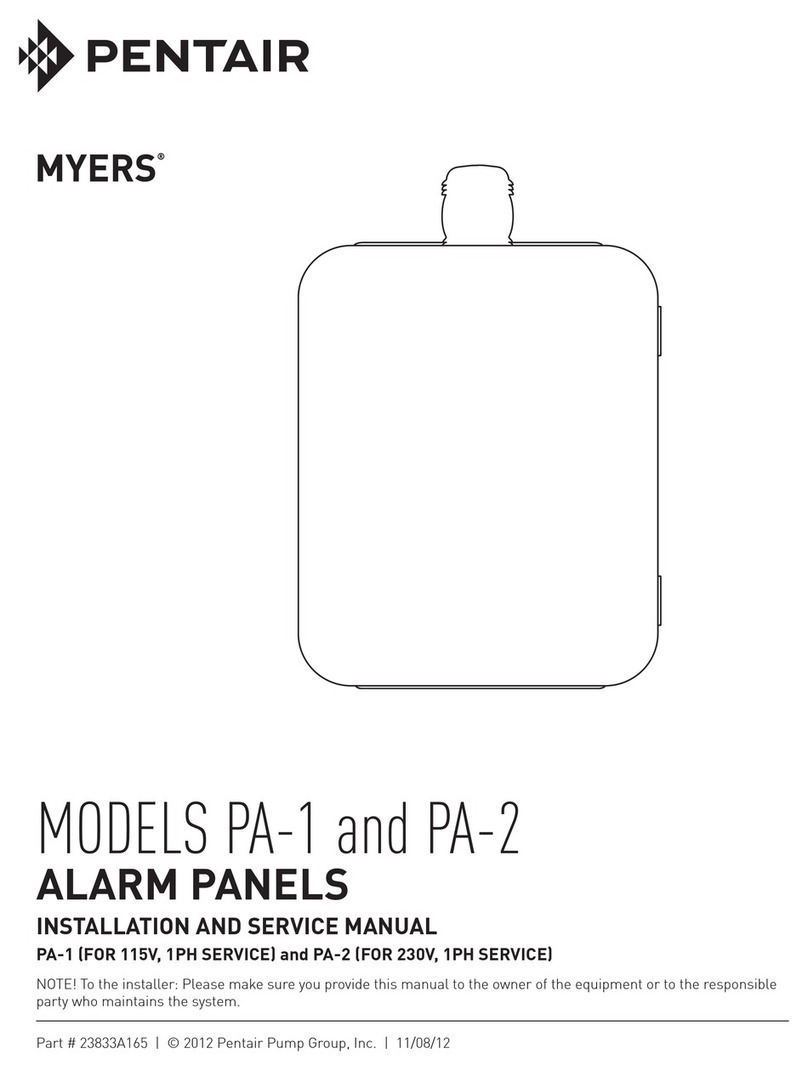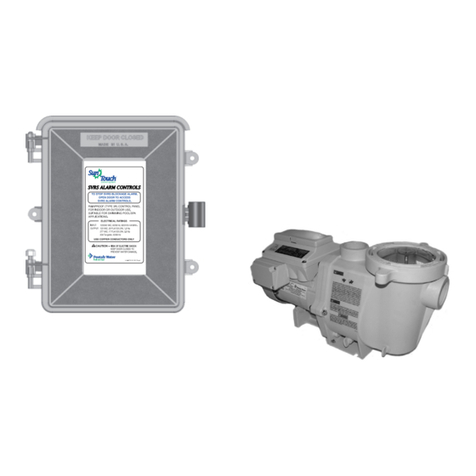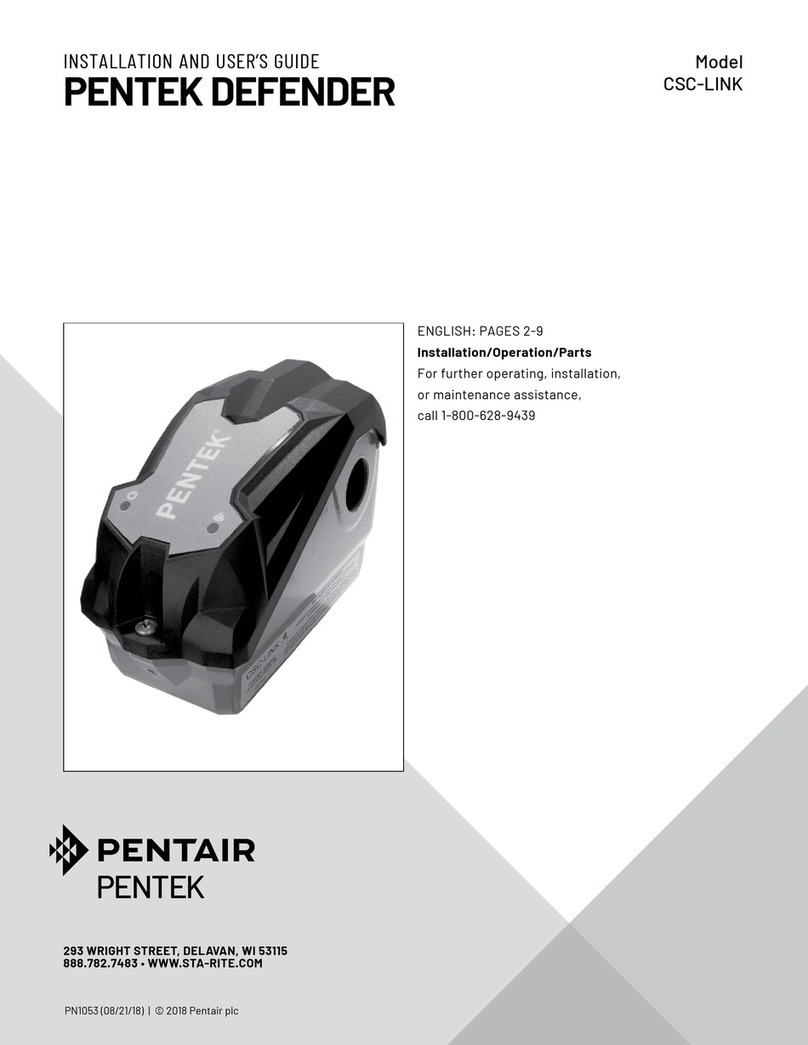
6
ITALIANO
Avete acquistato un prodotto Pentair Jung Pumpen di eleva-
te prestazioni e qualità. Eseguire un'installazione conforme
alle istruzioni operative per garantire che il nostro prodotto
rispecchi pienamente le aspettative dell'acquisto. I danni
causati da un uso non conforme invalidano la garanzia.
Il presente apparecchio può essere utilizzato da bambini a
partire da 8 anni e da persone con disabilità siche, sen-
soriali o mentali o carenza di esperienza e conoscenze, se
sottoposti alla supervisione o sono state istruite sull'uso
dell'apparecchio e ne hanno compreso i pericoli risultanti. Ai
bambini non è consentito giocare con l'apparecchio. La pu-
lizia e la manutenzione dell'utente non può essere eseguita
da bambini senza supervisione.
Prevenzione dei danni in caso di guasto
Come ogni altro apparecchio elettronico, anche questo prodot-
to subisce la tensione di rete errata o altri difetti tecnici.
Qualora il malfunzionamento del prodotto possa causare un
danno (anche indiretto), è necessario mettere in atto partico-
lari misure preventive in base alle proprie valutazioni:
•Installazione di un sistema di allarme legato al livello
dell’acqua (a seconda delle condizioni anche indipendente
dalla rete) in modo che l’allarme si attivi prima del vericarsi
di un danno.
•Verica della tenuta del serbatoio di raccolta / pozzetto no
al bordo superiore prima - o al più tardi durante - il montag-
gio e/o la messa in funzione del prodotto.
•Installazione di protezioni dal ristagno per gli elementi di
scarico nei quali può vericarsi un danno dovuto alla fuorius-
cita di acqua di scarico dopo un malfunzionamento.
•Installazione di un ulteriore prodotto, che possa compensa-
re il malfunzionamento del prodotto (es. impianto doppio).
•Installazione di un apparecchio di corrente d’emergenza
Dato che queste misure preventive servono ad evitare e/o ri-
durre al minimo i danni indiretti in caso di malfunzionamento
del prodotto, devono essere obbligatoriamente rispettate
come istruzioni del produttore durante l’utilizzo del prodotto, in
maniera analoga alle indicazioni normative della norma DIN EN
come stato della tecnica (OLG Frankfurt/Main, Az.: 2 U 205/11,
15.06.2012).
INDICAZIONI DI SICUREZZA
Le presenti istruzioni di funzionamento contengono infor-
mazioni di base da rispettare in fase di installazione, funzio-
namento e manutenzione. È importante che le istruzioni di
funzionamento vengano lette dall’installatore e dal personale
specializzato/gestore prima del montaggio e della messa in
funzione. Le istruzioni devono essere sempre disponibili sul
luogo di impiego della pompa e dell’impianto.
Il non rispetto delle indicazioni di sicurezza può causare la per-
dita di eventuali diritti di risarcimento danni.
Nelle presenti istruzioni di funzionamento le indicazioni di
sicurezza sono contrassegnate con determinati simboli.
L’inosservanza può essere pericolosa.
Pericolo generico per le persone
Pericolo tensione elettrica
Avviso! Pericolo per macchinari e funzionamento
Qualicazione del personale
Il personale per l’uso, la manutenzione, l’ispezione e il mon-
taggio deve presentare un livello di qualica conforme e deve
essersi informato studiando esaustivamente le istruzioni di
funzionamento. Le aree di responsabilità, competenza e il
monitoraggio del personale devono essere regolamentate
in modo preciso dal gestore. Se il personale non dispone del
giusto grado di conoscenze richieste, è necessario provvedere
all’istruzione e alla formazione dello stesso.
Operazioni in consapevolezza della sicurezza
Rispettare le indicazioni di sicurezza presenti nelle istruzioni di
funzionamento, le normative in vigore a livello nazionale sulla
prevenzione degli infortuni, nonché eventuali normative sul la-
voro, funzionamento e sulla sicurezza.
Indicazioni di sicurezza per il gestore/utente
Le disposizioni in vigore, le normative locali e le disposizioni in
materia di sicurezza devono essere rispettate.
Eliminare i pericoli dovuti all’energia elettrica.
Le perdite di liquidi pompati pericolosi (ad es. liquidi esplosivi,
velenosi, bollenti) devono essere gestite in modo che non co-
stituiscano un pericolo per le persone o per l’ambiente. Osser-
vare le norme in vigore.
Indicazioni di sicurezza per le operazioni di montaggio,
ispezione e manutenzione
In linea di principio si devono eseguire operazioni solo a mac-
china spenta. Le pompe o i gruppi che pompano sostanze peri-
colose per la salute devono essere decontaminati.
Subito dopo il termine delle operazioni si devono reinstallare
e rimettere in funzione tutti i dispositivi di sicurezza e prote-
zione. La loro ecienza deve essere controllata prima della
rimessa in esercizio, in ottemperanza alle attuali norme e dis-
posizioni in materia.
Modiche autonome e produzione dei pezzi di ricambio
Le modiche alla macchina sono consentite solo in accordo
con il produttore. I pezzi di ricambio originali e gli accessori au-
torizzati dal produttore garantiscono la sicurezza. L’uso di altri
pezzi può invalidare la responsabilità per le conseguenze che
ne dovessero derivare.
Modalità di funzionamento non consentite
La sicurezza di funzionamento della macchina acquistata è
garantita solo da un utilizzo conforme alle disposizioni. I valo-
ri limite indicati nel capitolo “Speciche tecniche” non devono
essere superati in nessun caso.
Indicazioni per la prevenzione degli incidenti
Prima di eseguire operazioni di montaggio o manutenzione, bl-
occare l’area di lavoro e vericare che il sollevatore funzioni in
modo irreprensibile.
Non eseguire mai lavori da soli; utilizzare sempre casco e oc-
chiali di protezione e scarpe di sicurezza, nonché, se necessa-
rio, imbracatura di sicurezza idonea.
Prima di eseguire saldature o utilizzare dispositivi elettrici,
controllare che non ci siano pericoli di esplosione.
Se nell’impianto per acque cariche lavorano persone, queste de-
vono essere vaccinate contro eventuali agenti patogeni presen-
ti nell’area di lavoro. Prestare attenzione alla pulizia e alla salute.































